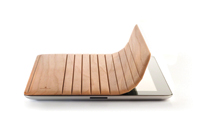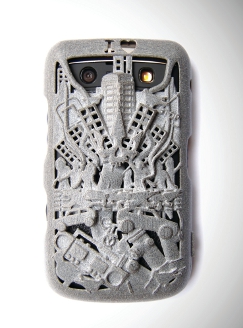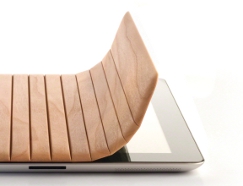Print works
Using 3D printing to produce the end product for consumer goods is considered by many to be the future, however Freedom Of Creation (FOC) are well ahead of the game.
“When producing everything with 3D printing and designing it all in 3D, we are able to bring products to the market that are aimed to the mass of niches rather than mass markets,” exclaims founder of FOC Janne Kyttanen.
“We can create products with different features for every mobile device regardless if they are high movers or not. Thus, contrary to other companies who only target the high moving devices such as the iPhone or Blackberry, we can target them all.”
The company, based in Amsterdam, produces an inspiring range of products ranging from lampshades to wall coverings, seating to jewellery. 3D printing is at the core of everything.
The phone and tablet cases come in a variety of different patterns and weaves, mostly designed by Kyttanen himself.
At FOC sketching is a thing of the past – everything goes straight into 3D CAD and then straight into 3D printing to make the development cycles extremely fast.
The biggest challenge with this process is quality. Producing 100,000 units of the same, but slightly customised products and not getting any returns.
So is computer-aided simulation something FOC relies heavily on? “No,” is Kyttanen’s frank reply. “I have a good gut feeling, which I have developed over the last 10 years, so testing on the computer is not needed anymore.
“I just look at the product on the screen and I know how it comes out of the machine. Pretty much like a good painter sees his painting in his minds’ eye, before it is finished. I can visualise complex engineering assemblies in 3D with relative ease.”
Everything is as much a work of art as it is a highly functioning product.
www.freedomofcreation.com
Patterned protector
A problem with cases is that they can often hide the beautifully designed product that you’re trying to protect, so a minimal approach is often a welcome one.
The Jbare Design iPad Wrap allows the beauty of the hardware underneath to shine through, and involves no opening or closing.
“I knew I would be getting [an iPad] so I began to think about protecting the thing,” says Jeff Bare, the man behind Jbare Design. “I decided a minimal wrap that covered the corners and kept the iPad from
resting directly on its aluminium back would be ideal.”
Protecting the surfaces with minimal bulk (it adds only 4mm extra in width), the sides remain open so when handling the iPad it is protected, but your hands only feel the bare iPad.
Bare sketched out a variety of designs by hand, incorporating core feature sets, such as magnets for on the fridge, kickstands, handles and hooks.
Playing around with these in Photoshop and Sketchbook Pro on the iPad, patterns were then drawn up in Adobe Illustrator before moving into 3D and SolidWorks, including its rendering program Photoview 360.
Then came the clever part: Having used 3D printing to produce prototypes to prove the fit of the case, the same method could be used to allow custom, on-demand designs. “3D printing was a vital role in the development of the iPad Wrap,” explains Bare. “Online 3D printing fabricators Shapeways has a great service, which I used exclusively for this project.
“3D printing made getting the fit perfect, to trying out different patterns on the back easy. Being able to continually iterate this product and push updates to customers instantly is an incredible power.
“’Iterate, iterate, iterate’ is something I hear in web/software product design advice often: on demand manufacturing makes that possible to achieve in my design field, and I love it. I iterate, push it out to the customers, get feedback, and iterate again,” exclaims Bare.
The final product is a lightweight protector that gives the customer as much input as to how they want their case to look as the designer has.
www.jbaredesign.squarespace.com
Natural protection
As much as the new iPad 2 cover has brought a smile, with its ability to fold, roll and position the device, there’s something quite natty about it.
It’s bright, cheerful and functional, but what I want is to get back to nature: some classic veneers and intricate carving – For all the Apple device’s polished glass and jet black aluminium, there’s something
comforting about smothering the new iPad in a sheath of wood.
Miniot have been designing covers for Apple devices from real wood since the iPhone 3G and the iPod Classic, with the natural progression being to design a cover for the latest addition to the Apple stable.
It’s clever too: a tight louvre design allows the solid wood face to roll back into a solid stand for the fancy tablet to rear up on so you can watch movies, type, or even display it in portrait.
Made individually by the tiny company in its Netherlands workshops, the sketches are transformed into 3D using Rhino before the data is transferred to Miniot’s CNC machine.
The final covers are carved from a single piece, with the choice of six different woods – oak, padouk, smoked oak, walnut, maple and cherry – or even a mixture for the different segments (our personal preference is cherry).
Magnets are attached, allowing the cover to stick both to the iPad and itself when rolled, and this is then covered with an ultrasuede microfiber on the inner.
Hand finishing removes any sharp edges or possible splinters, and leaves the light, 3mm thick cover with a ‘hand-made’ look of traditional craftsmanship.
For something more personalised you can even have an image laser-etched onto the wood – making the fine timbers of your casing look even more refined.
www.miniot.com
Get protected: beautiful and functional façades for smartphones and iPads








